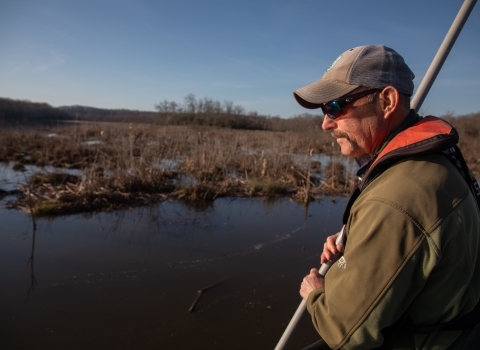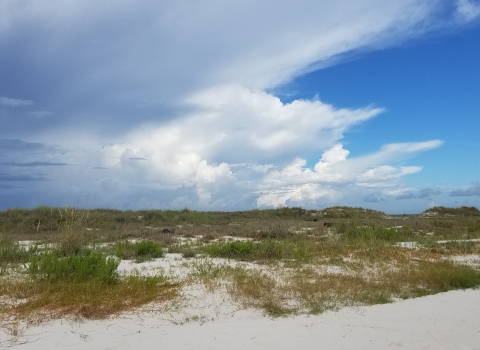Flying fish are not a common sight in the canyons of Northern Arizona; however, each fall approximately 300 endangered Humpback Chubs can be found soaring high above the Little Colorado River (LCR) on the way to their new home, just a few miles upstream. This helicopter-assisted transport is part of a conservation effort which began in 2003 by Arizona Fish and Wildlife Conservation Office (AZFWCO) biologists to collect juvenile Humpback Chub from the Little Colorado River near the confluence and release them upstream. The intent of this translocation project has been to introduce juvenile Chubs to a section of the LCR in which they did not previously occupy, so that they might imprint to the area and either stay or return later to spawn. Through this process and additional monitoring, AZFWCO hoped to establish and document an extension and expansion of the Chub population in the LCR and Colorado rivers.
The LCR watershed is expansive and stretches from the White Mountains of Eastern Arizona to the Colorado River as it cuts through Northern Arizona. While much of the river no longer flows perennially, it continues to be spring-fed for the last 13 miles before it flows into the Colorado River. This lower LCR is an important resource for the Humpback Chub in the Grand Canyon. Each spring, thousands of these federally endangered fish utilize its warmer waters to spawn. The river itself is a travertine system, characterized by seasonal flooding; saline, turquoise water; and a series of waterfalls that act as impediments, yet not necessarily barriers, to upstream migration of these native fish. One of these travertine obstructions, called Chute Falls, is located almost nine miles above the confluence and may act more like a barrier than others, as prior to 2003, there were no recorded captures of Humpback Chub in the waters upstream of it. It is here, above Chute Falls, where the young Chubs are released to make their new home.
A Humpback Chub translocation trip with AZFWCO looks quite similar to a typical LCR monitoring trip. In fact, in 2014 we began combining them with our October population monitoring efforts. For these joint trips, the crew consists of five or six people, typically a mix of AZFWCO biologists, partner agency biologists, and volunteers tasked with sampling the fish community within a 5-kilometer section of stream (60 hoop nets set for three nights each) and collecting, holding, tagging, and transporting 300 age-0 or age-1 Humpback Chubs, all within 10 days.
Once the monitoring part of the trip is complete, the crew sets out between 30 and 35 hoop nets, each one baited with markedly fragrant fish feed, in areas most likely to capture young Chubs. These nets are typically checked a couple of times per day. In some years, the river is muddy and we need to supplement our efforts with seine and dip netting near sandy beaches, side channels, and vegetation banks. This constitutes a particular challenge, as the LCR river bed consists of a striking number of snags and inconveniently positioned boulders, quite invisible below the water-line. If a captured Chub fits into the target size range (80-130mm), it is transported back to camp in an aerated 5-gallon bucket and held in the river within floating plastic trash barrels, modified to allow water to flow through. Each fish set to be translocated is measured and given a passive integrated transponder (PIT) tag, making it possible to track individual growth and movement. The juvenile Chub are moved to a lined 55-gallon drum outfitted for helicopter long-line attachment and taken on their soaring journey to their new home.
Between 2003 and 2019, AZFWCO translocated 3,776 juvenile Humpback Chub from the lower reaches of the LCR to above Chute Falls and by 2018 more than 1,163 of them had been recaptured in the LCR both above and below Chute Falls and in the Colorado River. We found that the translocated Chubs that were recaptured above Chute Falls grew significantly faster and reached adulthood (200mm) a year or two earlier than those from the same cohorts that were never translocated. Two factors that appear to drive the higher growth rates above Chute Falls are prey abundance and water temperatures. During the course of this project, capture rates for Speckled Dace, a common Chub prey species, were 60 times higher above Chute Falls than lower in the river. The hydrology of the LCR is highly variable and seasonal flooding is common in the spring and fall. However, annual mean water temperatures at base flow, on average, are higher above Chute Falls than near the confluence and Humpback Chub growth rates are significantly correlated with these higher temperatures.
The faster growth above Chute Falls is important for management and conservation of the Grand Canyon Chub population because it likely means increased survival resulting in a greater overall benefit to the population. We know that many of the translocated fish end up moving downstream and mixing with the greater LCR Chub population. We have also documented male and female adult Chubs in spawning condition, some un-tagged juveniles, and small age-0 Chubs above Chute Falls. These observations seem to indicate that the translocated fish continue to contribute to Chub production in the Little Colorado River. As a management action, it seems, flying fish is a relatively simple and effective tool to augment the adult Chub population in Grand Canyon.
For more information about methods, results, and conservation implications of the LCR translocation project, check out our April 2020 article in the North American Journal of Fisheries Management.




